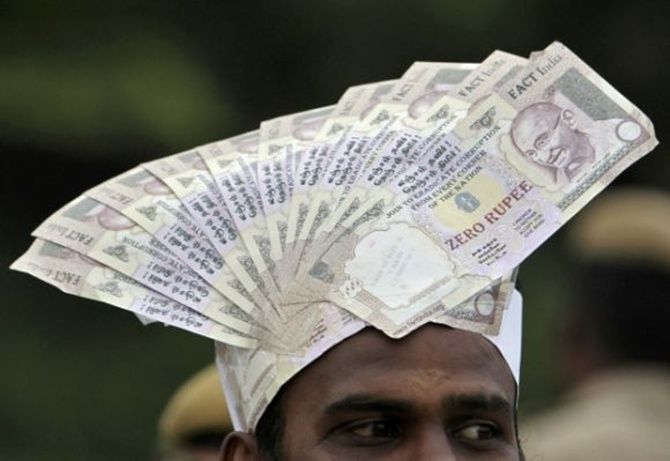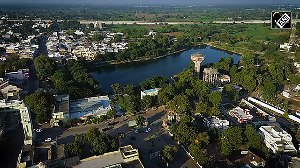The finance ministry and RBI must get less conservative and improve co-ordination, notes Ajay Chhibber.
 The US Federal Reserve's decision not to raise interest rates signals that it is more concerned about deflation than it is about inflation.
The US Federal Reserve's decision not to raise interest rates signals that it is more concerned about deflation than it is about inflation.
The Fed is trapped in its own "Chakravahyu" - it got into an extended quantitative easing (QE) but does not know how to get out of it. Japan and the EU are still pushing out more QE.
Many emerging market (EM) central banks, including China's, have lowered interest rates.
The last hold out remains the Reserve Bank of India (RBI) - fighting a battle against inflation that is already over.
India now has one of the highest real interest rates globally. India needs to focus on growth and jobs and someone needs to now telegraph this to the RBI, which remains the "last man standing" in a battle long over.
This does not mean that inflation is dead forever - it may resurface again - when the global commodity cycle picks up. But that is a battle that must be fought then.
The RBI is now needed to get less risk-averse and put its shoulder to get the growth cart rolling.
The RBI is correct to use the Consumer Price Index (CPI) - not the Wholesale Price Index (WPI) or the gross domestic product (GDP) deflator as some, including the chief economic advisor, have suggested.
Open bickering between the RBI and the finance ministry is not helpful.
But even so, with the benchmark interest rate at 7.25 per cent and the CPI now below four per cent, India's real interest at around 3.5 per cent is among the highest in the world.
The RBI rightly points out that consumer inflationary expectations are based on the CPI. Nevertheless, the trends in the WPI are worth noting.
The continuous decline in the WPI will eventually show up in further declines in the CPI with a lag of six-nine months, as production costs decline.
The RBI was behind the curve when inflation rose in 2009-10 and remains behind the curve now, when inflation is again declining.
Why is the RBI so stubbornly conservative and repeatedly wrong in recent times is a puzzle?
CPI inflation rose in 2008 on the back of rising commodity prices and began to decline in 2014 as global commodity prices fell. The drop in the CPI could have perhaps come a bit earlier had India managed its internal food policy better.
But now that WPI inflation has been negative for the past 10 months, the CPI will fall even further.
The core inflation over which RBI has some impact with a lag - and which should have been the right indicator to use in an inflation target framework if we had to have one - is also trending below the target levels. India has also enough food and forex reserves to manage the food price effects of a weak monsoon.
RBI's high interest rate policy is now seriously hurting recovery. With the old or new GDP series, indications are that growth is trending down not up.
No doubt much more is needed to revive growth than just low interest rates but a high interest rate regime is not helping kick-start recovery.
India's macroeconomic snapshot today - low inflation, lower fiscal deficit, low current account deficit - are an IMF picture postcard of a perfect economy.
Unfortunately, RBI policies, like many old-style IMF stabilisation programmes, are now only helping the financial markets, not the real economy.
The high interest rate regime and the overvalued exchange rate is certainly helping banks and the financial markets. Short-term investors are also very happy and stocks have ticked upwards again after a correction.
But the underlying real economy remains weak.
The world over India is now heralded as the best EM - not surprising as we are a commodity importer and the world's fastest growing economy - with an upward correction of two percentage points in new GDP growth - but yet the investment ratio is falling, capacity utilisation remains low and export growth has dropped sharply.
Prospects for exports look weak as growth in global trade falls even below the slow growth in global GDP for the first time. India should nevertheless be able to do more on the export side.
The rupee has weakened a bit against China but has strengthened against many of our export competitors.
While the recent strengthening may be temporary and the rupee will decline again once the Fed does raise rates by the end of 2015, it remains at least 10-15 per cent overvalued.
Global experience shows that a 10-15 per cent real devaluation could be a shot in the arm for an export surge.
To make up for lost time, the RBI must now lower rates by at least 100 basis points or provide two quick doses of 50 basis points and persuade banks to pass through the 45 basis points - of the previous 75-basis-point cuts by the RBI in its benchmark rate, banks on average have passed on only about 30 basis points - that they have absorbed in their balance sheets.
This would result in a roughly 150-basis-point reduction in lending rates.
The government has also not done enough to jump-start recovery.
Unlike other BRICS, India is a commodity importer not a producer and should have benefitted more from falling commodity prices had we seized the opportunity.
The drop in fuel prices were not fully passed through and have been absorbed by the government.
These funds could have been used to further increase public investment but have probably been set aside for OROP or as a cushion against the likelihood that disinvestment receipts of almost Rs 70,000 crore (Rs 700 billion) in the Budget will not be realised.
It's time for the finance ministry, the RBI and the banking sector to stop being so conservative and get better coordinated for jump-starting a recovery.
Lower the rates by 100 basis points, get the banks to pass through the previous cuts by 50 basis points, and increase further infrastructure spending and then hope private investment gets crowded in by 2016. No parliamentary action is required for these measures.
The writer is Visiting Distinguished Professor at NIPFP and Visiting Scholar at IIEP, George Washington University. Views are personal.









